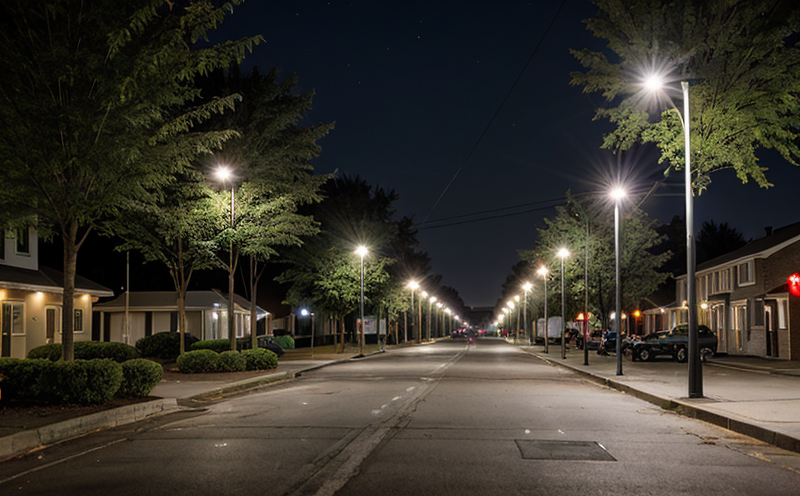EN 50102 Mechanical Impact Testing of Outdoor Lighting Devices
The European standard EN 50102 specifies mechanical impact tests to ensure that outdoor lighting devices can withstand environmental stresses and external impacts. This test is crucial for the quality, safety, and longevity of streetlights, traffic lights, and other public lighting fixtures. The primary goal of this testing is to validate that these devices meet the necessary performance criteria under various specified conditions.
EN 50102 defines a series of tests aimed at assessing the mechanical robustness of outdoor lighting devices against impacts from falling objects such as stones, branches, or debris. These tests are particularly important in urban and rural areas where such hazards may occur frequently due to weather conditions or human activities.
The testing procedure involves exposing the light fixtures to a series of predefined impact forces using standardized test equipment. The specimen is typically mounted on a vertical stand that can be adjusted for different heights, simulating real-world conditions. During the test, the fixture is subjected to impacts from a falling mass with varying weights and velocities.
Compliance with this standard ensures that outdoor lighting devices are robust enough to function effectively in challenging environments without sustaining damage or compromising performance. This testing helps manufacturers ensure their products meet regulatory requirements and perform reliably under expected conditions, thereby enhancing public safety and reducing maintenance costs over the long term.
The test parameters include the mass of the impactor (typically 1 kg), its velocity upon impact, and the height from which it falls. The acceptance criteria for this test are based on visual inspection; any damage to the fixture or changes in functionality post-test would indicate a failure. Compliance with EN 50102 is essential for manufacturers aiming to sell their products within European markets.
Understanding the real-world implications of these tests, quality managers and compliance officers can ensure that their organizations are meeting regulatory requirements and customer expectations. R&D engineers benefit from this standard by gaining insights into material selection and design improvements needed for enhanced durability. Procurement teams also find value in ensuring suppliers meet these rigorous standards to maintain high-quality products.
| Parameter | Description | Value |
|---|---|---|
| Impactor Mass | Mass of the falling object used in the test. | 1 kg |
| Velocity upon Impact | The speed at which the impactor strikes the specimen. | 5 m/s |
| Fall Height | The height from which the impactor is dropped. | 1 m |
Why It Matters
Ensuring that outdoor lighting devices meet EN 50102 standards is critical for several reasons. First, it guarantees the safety of pedestrians and vehicles by preventing accidents caused by defective or damaged streetlights. Secondly, compliance with this standard enhances public trust in infrastructure providers, fostering a positive reputation. Additionally, meeting these requirements can help reduce maintenance costs over time as robust fixtures require fewer repairs.
The long-term benefits extend beyond immediate safety and functionality; they contribute to the overall sustainability of urban environments by promoting efficient energy use and minimizing environmental impact. By selecting products that pass EN 50102 tests, organizations demonstrate their commitment to responsible practices and regulatory adherence.
Industry Applications
| Industry Sector | Application |
|---|---|
| Transportation | Testing of traffic signal and street lighting systems. |
| Construction | Evaluation of portable work lighting solutions for site safety. |
| Agriculture | Assessment of security lighting used in rural areas. |
| Sports and Entertainment | Evaluation of emergency lighting systems for large events. |
Why Choose This Test
Selecting EN 50102 mechanical impact testing offers numerous advantages. Firstly, it provides a standardized method for evaluating the durability of outdoor lighting devices under realistic conditions. Secondly, it ensures that products meet stringent safety and quality standards recognized across Europe. Thirdly, compliance with this standard can significantly reduce warranty claims and recalls by identifying potential issues early in the product lifecycle.
Moreover, passing EN 50102 testing demonstrates a company's commitment to innovation and continuous improvement, which is increasingly valued by consumers and stakeholders alike. This certification also opens up opportunities for international markets where compliance with European standards is essential. Lastly, it enhances brand reputation and customer confidence, contributing to long-term business success.





